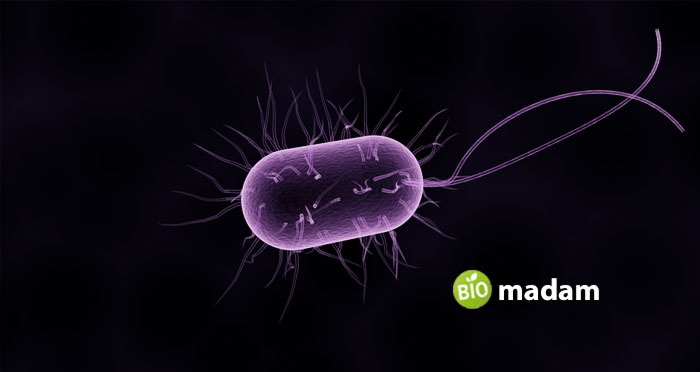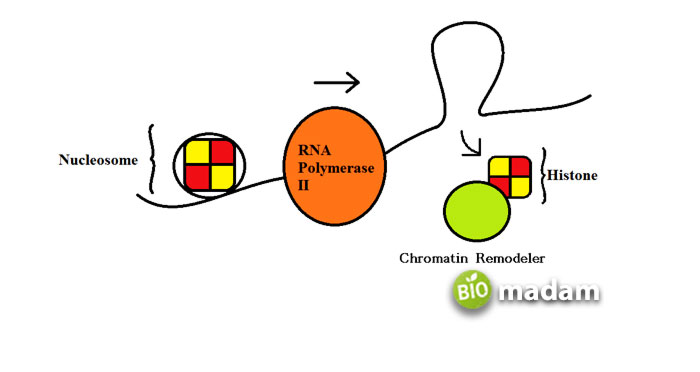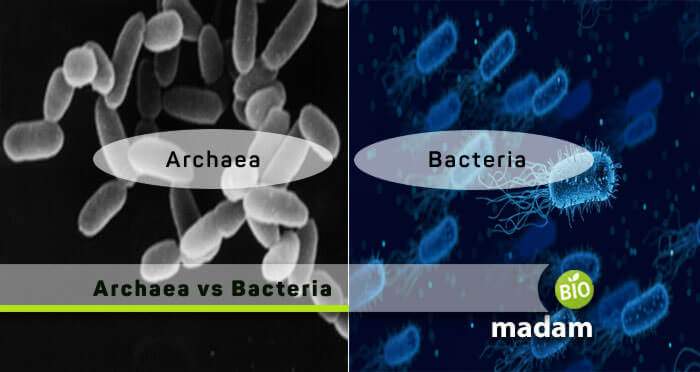In the past, archaea were considered a part of bacteria with a popular name, “archaebacteria.” However, with the passage of time, scientists started finding differences between archaea and bacteria because their evolutionary history was different. If you too want to know archaea and bacteria differences, continue reading the article below.
Before stepping into understanding archaea vs bacteria, remember that both are prokaryotic organisms, but entirely different. Archaea is observed to have commonalities with both eukaryotes and prokaryotes. While on the other side, bacteria are a group of single-celled prokaryotes, present almost everywhere, around us, and on us. Let’s grab a quick comparison chart to know more about the two!
Comparison Chart
| Comparison | Archaea | Bacteria |
| Composition of Cell Wall | Pseudo-peptidoglycan or glycoprotein cell wall | Peptidoglycan |
| Ribosomes | Absent | Present |
| Type of Cell Membrane | Lipid monolayer/bilayer | Lipid bilayer |
| Membrane Lipids | Phytanyl glycerol ethers | Fatty acids, glycerol ethers |
| tRNA | Methionine | Formyl-methionine |
| Number of DNA Polymerase | Multiple | Single |
| Chromosomes | Introns present | Introns absent |
| Types | Methanogens, Halophiles, and Thermoacidophiles | Gram-positive bacteria & gram-negative bacteria |
| Pathogenicity | Non-pathogenic | Can be pathogenic or non-pathogenic |
| Examples | Sulfolobus acidocaldarius, S. marinus, Pyrolobus fumarii, etc. | Escherichia coli, S. aureus, and Lactobacillus acidophilus |
What is Archaea – Brief Explanation
These are the unicellular prokaryotes, entirely different from bacteria and eukaryotes. An archaeon utilizes several energy sources to meet its needs. These organisms either rely on ATP or carbon compounds to gain nutrition. The group of archaea using sunlight to prepare their food are called phototrophs. While in contrast, archaea using ammonia and sulfur (inorganic substances) fall in the second category to release ATP. This process is quite similar to those occurring in eukaryotes. Thus, archaea somehow relate to multicellular organisms in their characteristics but still lack a nucleus.
They differ in size, ranging from 0.5 to 4 µ, and have bacteria-like shapes, such as rods, spirals, and spheres. Archaea possess the cell wall, made up of pseudo peptidoglycans.

What is Bacteria – Brief Explanation
Bacteria or eubacteria are unicellular living bodies that lack a distinct nucleus and membrane-bounded organelles like mitochondria and chloroplast other organelles. All bacterial cells have a boundary that not only supports but also protects and monitors the cell material. The cell wall of bacteria is nothing but peptidoglycan, which plays a role in shielding the cell from external factors. Moreover, all the bacterial reactions occur in the cytosol of cytoplasm, where some ribosomes and chromatin material help in replication.
Not only are this but there numerous processes by which the bacteria divide. It can reproduce by budding, binary fission, and also fragmentation. Furthermore, transferring of hereditary material can also take place through conjugation, transduction, and transformation

How Are Archaea and Bacteria Alike?
Although both differ in several things, you must be wondering what do bacteria and archaea have in common? When experts observed it under a microscope – both archaea and bacteria appear similar. The primary reason behind numerous similarities between archaea and bacteria is their shared prokaryotic nature. These are as below:
- These are unicellular organisms that are invisible with the naked eye.
- Both domains do have genetic material that are not properly enclosed in membranes. Instead, these are dispersed and scattered in the cell cytoplasm.
- Whether its archaea or bacteria, both have a single and circular DNA.
- When contrasting archaea and bacteria, scientists came to know that both organisms can undergo asexual reproduction, like binary fission and fragmentation.
- Last but not least, both contains cell wall and a typical cell membrane to protect the internal components.
Archaea vs Bacteria – Key Differences
Definition
Archaea
An archaeon is a unicellular body that lacks membrane-bounded organelles. Despite being a prokaryote, this organism follows eukaryotes in the replication of DNA.
Bacteria
Bacteria are the simple prokaryotes that live everywhere around us and are advantageous in many ways. Most bacteria are, nowadays, used by industries for human benefits.
Composition of Cell Wall
Archaea
These organisms have ether bonding, so the cell wall is composed of pseudo-peptidoglycans.
Bacteria
Bacteria have a lipid bilayer that interlinks fatty acids and ester bonds. All bacterial cell walls are made up of peptidoglycans called murein.
Membrane Lipid Composition
Archaea
The lipids in archaeal membrane are resistant to extremely harsh environments, such as changes in pH levels. All archaeal cell membranes have isoprenoids as lipids.
Bacteria
On the contrary, bacterial cell membrane contains amphiphilic lipids such as phospholipids and phosphatidylglycerol.
Found In
Archaea
Most archaea are present in peculiar environments, such as salt brines, ocean depths and hot springs, etc. It represents that all archaea are extremophiles.
Bacteria
On the other hand, most bacteria live underwater, in soil, in the air, and in living or non-living bodies.
Types
Archaea
There are generally three types of archaea, called halophiles, methanogens, and thermoacidophiles.
Bacteria
Similarly, bacteria are divided into two main types, called gram-positive and gram-negative bacteria.
Presence of Histone Proteins
Archaea
Most archaeal structures have histone-line proteins that associates with the DNA in its packaging, compaction, and regulation. It is similar in feature to eukaryotes.
Bacteria
In contrast, bacteria do not need any histone protein to associate with its DNA. These have circular chromosomal structures called plasmids that help the organism reproduce.
Reproduction Method
Archaea
As prokaryotes, they can reproduce asexually through fragmentation, binary fission, budding, etc.
Bacteria
Bacteria can either reproduce sexually or asexually. But the most favorable method of bacterial reproduction is through binary fission. It can also survive adverse conditions through spore formation.
Differences in Metabolism
Archaea
Archaea can survive in extreme conditions so it undergoes Methanogenesis. It is the only metabolic process that occurs in this organisms in harsh environments, producing methane as a byproduct.
Bacteria
However, on the contrary, bacteria are widely found everywhere around us. They are not typically associated with harsh environments, thus can undergo, photosynthesis, respiration, fermentation, and nitrogen fixation.

Genetic Features
Archaea
These organisms lack thymine in the transferase RNA but contain introns and exons.
Bacteria
In contrast, these unicellular organisms lack introns but contain thymine in the transferase RNA.
Ribosomal RNA Differences
Archaea
Archaea have RNA similarity with eukaryotes. The ribosomal RNA is structurally and functionally similar to eukaryotic rRNA than the bacterial rRNA.
Bacteria
On the other hand, the ribosomal RNA of bacteria is different from both RNAs – of archaea and eukaryotes.
RNA Polymerase
Archaea
These complex living bodies contain ten subunits of an RNA polymerase.
Bacteria
A bacterial cell has comparatively more mere RNA polymerase with four subunits.
Sensitivity to Antibiotics
Archaea
Due to the strong cell wall composition, archaea are highly insensitive towards antibiotics. These organisms are only susceptible to molecules that are effective against eukaryotes and other bacteria.
Bacteria
In opposite, bacteria are highly susceptible to different antibiotics (from low to high efficacy). It is because all bacteria have peptidoglycan in their cell wall that is easily attacked.
Examples
Archaea
A few of many archaeon examples include Sulfolobus acidocaldarius, Staphylothermus marinus, Pyrolobus fumarii, etc.
Bacteria
There are hundreds and thousands of bacteria present in our environment. These consist of Escherichia coli, Staphylococcus aureus, Staphylococcus pneumoniae, and Lactobacillus acidophilus, etc.
Reach a Verdict
After reading the article above, now you must know about the difference between archaea and bacteria. Despite existing as prokaryotes, they have distinct characteristics. The hydrophobic part of a bacterial cell membrane is a fatty acid, while for archaea, it is phytanyl. Furthermore, an archaeon cell wall is pseudo-peptidoglycans or glycoproteins, whereas it’s entirely peptidoglycan for bacteria.

Hello, I would like to introduce myself to you! I am Chelsea Rogers, an experienced blog writer for science articles, holding an MPhil degree. My enthusiasm to grab the best knowledge, let it relate to botany, zoology, or any other science branch. Read my articles & let me wait for your words s in the comment section.

